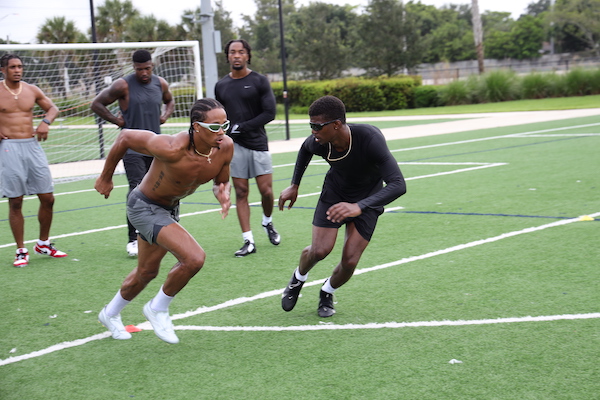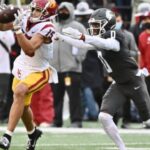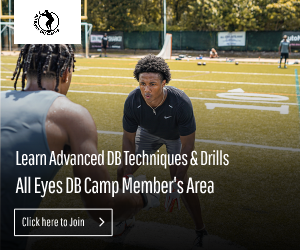Press man coverage is a very effective tool that defenses can use to neutralize some of the most potent passing attacks. Many feel that superior athletic ability is required to be effective in press man but that is not entirely true. The over arching thing that is necessary to be effective in press man is technique. When combined with proper deployment of coverage, even a team with slightly above average athletes in the secondary can be very effective in press. In this article, I will lay out the basic and effective ways coaches can teach press man coverage to their defensive backs.
Stance and Alignment
Start by teaching your defensive backs the proper stance for press man coverage. They should have a balanced stance with their feet slightly wider than shoulder-width apart. An important image to give your defensive backs who are just starting out is to take the same stance that they would if they were in the squat rack trying to squat 225 pounds. This should involve them having their feet up under them with their chest out. Whatever position you would take to best move that heavy weight, should be the same position you should take to be explosive out of your stance upon the wide receivers movement. Also, your defensive backs should find their proper depth away from the wide receiver. If the first movement by the wide receiver causes the defensive back to split his feet, open the gate or “spaz out“ then he is too close. Start at a yard and a half away from the wide receiver and work from there. You never really want to be more than 2 yards away and never closer than a yard unless your technique is to touch the wide receiver immediately upon his first move.
Footwork and Technique
In terms of foot work, it should be emphasized that short steps and body control are optimal. Hopping, long steps, and upper body leans while working to jam a receiver at the line of scrimmage should be discouraged. A rigid upper body combined with short, smooth, controlled steps will keep the defensive back in the proper position to execute a jam and change direction when necessary. There are mainly two types of techniques when playing press. One is hard press where the emphasis is on getting hands on the wide receiver and widening his release or there is soft press where there’s more of an emphasis on using your feet to mirror the release and stay in front of the receiver. I go more in depth on the contrast between these two techniques in this post, click here.
Jamming and Hand Placement
Demonstrate the proper technique for jamming the receiver at the line of scrimmage. Emphasize using the base of the palm to strike the receiver’s chest or shoulder pads, disrupting their release. Teach your players to keep their hands active throughout the jam, maintaining contact with the receiver while redirecting their route. Emphasize keeping the eyes down while using the hands. So basically, the defensive back is going to shoot his hands above his eyes. The goal is to strike the receiver’s chest while maintaining eye contact with his waist. Also, shooting the hands to the chest is favored over, attempting to strike the shoulder while at the line of scrimmage. This prevents the defensive back from missing the jam, if the wide receiver dips his shoulder. As the route progresses down the field, should strikes can be deployed.
Body Positioning and Leverage
Emphasize the importance of maintaining proper leverage according to the coverage being run. Some man coverages demand that the defensive back be inside of the wide receiver. Others favor the defensive back being on the outside of the receiver. Defensive backs should make a strong effort to maintain that leverage both at the line of scrimmage and throughout the route. Making sure they know where their help is will help them achieve this objective. Also, maintaining proper body position during the route will allow them to be with the wide receiver when the ball arrives. Defensive backs should be trying to maintain a decent amount of space (no more than arm’s length) during the route and then close out that space when the ball arrives so that they can defend a pass towards any part of the receivers body.
Recovery and Transition
Emphasize the need for quick recovery when the receiver gets a step on the defensive back. Teach your players to transition their body position while staying in phase with the receiver. Drills should be set up to teach effective techniques on defending routes both when the defensive back is in phase as well as out of phase. DB’s should be taught to maintain contact with the wide receiver while looking for the ball when in phase. They should also be taught how to play the hands of the wide receiver when they are out of phase and trying to catch up.
Communication and Film Study
Teach your defensive backs to communicate with their teammates, particularly the safeties, to ensure proper coverage assignments and help with over-the-top support. Incorporate film study sessions to analyze techniques, tendencies, and strategies of both the receivers and opposing offenses. Remember, repetition, attention to detail, and individualized coaching are crucial for mastering press man coverage. Provide feedback and correction consistently to help your players refine their technique and improve their performance.
Eye Discipline
Perhaps the most important factor in press man success is eye placement. It is also the most difficult thing for them to evaluate since they can’t see their eyes. As a coach, your biggest emphasis should be on correcting their eyes when they are out of place. Correct placement is largely a function of habit and repetition. Coach every rep as it pertains to eye discipline. Never let a rep with incorrect eye placement go by without correction.
These are the basic things that you will need to teach your players on how to be effective in press man coverage. Of course, there are other little things that are a part of it and you will notice what those things are as you begin teaching your players the technique. In addition, some of what you do will relate to the type of coverages you run as a defense. Following the steps outlined in this article will give your players a tremendous start to being very effective press man defensive backs. For more in depth articles with videos on press man coverage, consider joining the All Eyes DB Camp Member’s Area.
Chad Wilson is the owner of All Eyes DB Camp and author of "101 DB Tips". He played college football at the University of Miami and briefly in the NFL for the Seattle Seahawks. Over his 15 year high school football coaching career, he tutored over a dozen Division I defensive backs and as a trainer has worked with NFL All Pros, first round draft picks, college football All Americans and Top 10 ranked high school football prospects.









